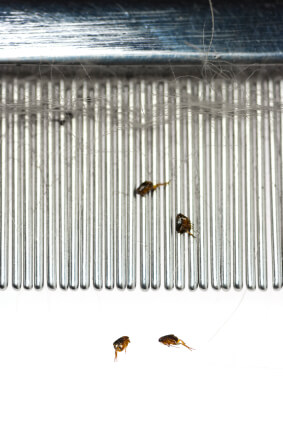While fleas are an especially common problem for dogs and cats during the summer months, pet owners in Southern California actually have to battle parasites year-round due to the temperate climate.
The best way to prevent a flea infestation is to keep pets on a constant and consistent flea control regimen. When your pet is on and off preventative medication, it is likely he/she will get fleas! If you do not use flea preventative medication and do not have a flea problem, you have been lucky. The truth is, however, that you will encounter an infestation eventually.
At The Drake Center, we recommend monthly Sentinel for dogs and a Bravecto topical solution every 12 weeks for cats. These products prevent a flea infestation in your home. During the warmer months, many dogs may also need Comfortis or Capstar (oral adulticides) or Parastar (a topical adulticide) to control parasites that may be picked up outdoors or from other animals. Cats may also need Easy Spot (a topical adulticide) if they go outside.
Adult fleas live on your pet and lay eggs. These eggs drop off into the environment, where they hatch into larvae. Larvae prefer to live in dark, low traffic areas, such as under the couch or between couch cushions. After a few days, the larvae molt into pupae (a cocoon-like stage) and can stay dormant for up to six months. Pupae live in carpeting, between floor boards or in shady outdoor areas. Once this stage is over, the adult flea will jump back onto your pet.
It is important to remember that your pet can get fleas while on a flea control regimen. If an unprotected dog (not on Sentinel) visits your home, for example, he/she can drop eggs into your pet’s environment. These eggs will hatch 14 days to one year later. Additionally, if your dog visits a friend or neighbor’s home and fleas are present, he/she may pick them up there. Remember, you cannot control every situation, but you can protect your home and your pets.
If your house becomes infested with fleas, we recommend immediately starting or restarting Sentinel and Bravecto and using topical control for at least three months. In addition, you’ll need to thoroughly clean the environment, especially the areas where your pet sleeps. If your pet sleeps in your bed, wash all bedding and make sure to clean around and under the bed. Vacuuming is important. Remove all couch cushions and vacuum them as well as under and around the couch.
It is important to note that during the cleaning process, you will not be able to remove all flea pupae—they will continue to hatch out. However, once you have your pet on the above routine, you will kill those fleas once they have hatched.
Outdoor areas will be harder to clean. Again, fleas will be found where your pet typically hangs out in the yard. Fleas especially enjoy dark, leafy areas, such as under shrubs or porches. To rid your outdoor environment of fleas, first clean all leafy debris away. If you have a severe outdoor infestation, you may also want to consider Virbac Yard Spray, which attaches to a garden hose and is intended to be sprayed under porches and around the yard. Keep in mind, however, that this is rarely a necessity as the vast majority of the problem is in your house where your pet sleeps.
Fleas can be very frustrating to eradicate, but with your veterinarian’s help, you can win the battle!

